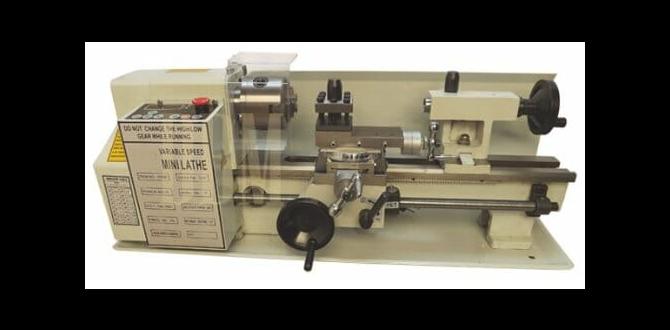Wood lathe duplicator system explained in detail offers a revolutionary approach to creating identical turned wood components, a game-changer for woodworkers of all skill levels. Whether you’re a hobbyist seeking to replicate a specific design for a project, or a professional needing to produce multiple identical parts for furniture or craft items, a duplicator system can drastically improve efficiency, accuracy, and consistency. Gone are the days of tedious and often imprecise hand-copying, where slight variations could lead to mismatches and wasted material. This guide will delve into the intricacies of these systems, their benefits, how they work, and what to consider when choosing and using one.
Historically, achieving perfectly matched turned wood pieces relied on a craftsman’s keen eye, precise measurements, and considerable skill. This often involved making a master piece and then meticulously measuring and shaping each subsequent piece to match. For repetitive tasks, this was a time-consuming and error-prone process. The advent of the wood lathe duplicator system fundamentally changed this paradigm. It introduced a mechanical or electronic guiding mechanism that directly transfers the profile of a master piece onto the workpiece being turned.
How Does a Wood Lathe Duplicator System Work?
At its core, a wood lathe duplicator system operates on a simple yet ingenious principle: master-to-copy replication. The system typically consists of three main components: a master template (or stylus), a follower arm, and a cutting tool attachment.
1. The Master Template/Stencil: This is a precisely shaped piece of material that represents the exact profile you want to replicate. It can be a pre-made template made of metal, wood, or even durable plastic, or it can be a piece of wood that you have already turned to your desired specifications. The template is usually mounted parallel to the workpiece on the lathe bed.
2. The Follower Arm/Stylus: This component is designed to trace the contour of the master template. It’s usually a hardened steel stylus or roller. As the lathe spins, the follower arm is guided along the edges of the master template.
3. The Cutting Tool Attachment: This is where the magic happens. The follower arm is mechanically linked to the tool rest or a dedicated cutting tool holder. As the follower arm moves along the template’s profile, this movement is transferred directly to the cutting tool. This ensures that the cutting tool carves the same shape into the spinning workpiece as the follower traces on the master.
There are generally two primary types of duplicator systems: manual and powered. Manual systems rely on the operator to move the follower arm and, consequently, the cutting tool. Powered systems, on the other hand, use electric motors or pneumatic actuators controlled by the follower arm to move the cutting tool automatically along the workpiece. Powered systems often offer greater precision and reduce operator fatigue.
Benefits of Using a Wood Lathe Duplicator System
The advantages of incorporating a wood lathe duplicator system into your workshop are numerous and can significantly impact your workflow and the quality of your output.
Unmatched Consistency and Accuracy: This is the most significant benefit. Whether you’re turning ten identical spindle components or a series of matching decorative elements, a duplicator system ensures each piece will be virtually indistinguishable from the last. This eliminates guesswork and the frustration of slight variations.
Increased Efficiency and Speed: Once set up, a duplicator system dramatically speeds up the production of multiple identical items. The manual effort is reduced to guiding the tool and monitoring the process, rather than constantly measuring and reshaping.
Ease of Use for Beginners: For those new to woodturning, mastering complex shapes can be daunting. A duplicator system allows beginners to achieve professional-looking results by essentially “copying” a pre-made shape, building confidence and skill.
Reproducing Complex Designs: Intricate or complex profiles that would be challenging to replicate by hand can be easily reproduced with a duplicator system, provided a suitable master template is available.
Cost-Effectiveness for Repetitive Tasks: While the initial investment in a duplicator system might seem significant, for projects requiring the production of many identical parts, the time saved and the reduction in material waste can quickly offset the cost.
Types of Wood Lathe Duplicator Systems
While the fundamental principle remains the same, wood lathe duplicator systems come in various designs to suit different lathes and user preferences.
Bed-Mounted Duplicators: These are the most common type. They typically attach directly to the lathe bed, positioning the template parallel to the workpiece. The follower arm and cutting tool assembly move along this guide.
Tool Post Mounted Duplicators: Some systems mount directly to the lathe’s tool post, allowing for a more integrated approach. These can sometimes offer greater maneuverability but might have limitations on the size of the template or workpiece.
Laser-Guided Systems: A more advanced category exists, using laser lines to guide the cutting tool. While not strictly “duplicators” in the template-following sense, they offer a high degree of accuracy and visual guidance for replicating shapes.
When considering a wood lathe duplicator system, it’s important to research compatibility with your existing lathe, the types of templates it can accommodate, and the overall build quality.
Setting Up and Using Your Duplicator System
Proper setup and usage are crucial for maximizing the benefits of your duplicator system.
1. Mounting the System: Follow the manufacturer’s instructions carefully for securely attaching the duplicator system to your lathe. Ensure it is stable and doesn’t introduce vibrations.
2. Preparing the Master Template: Create or select your master template. Ensure its surface is smooth and free of imperfections that could be transferred to your workpiece.
3. Aligning the Master and Workpiece: This is a critical step. The master template must be perfectly aligned with the axis of rotation of your workpiece. Imprecise alignment will directly translate into inaccurate copies.
4. Setting Up the Cutting Tool: Attach your chosen cutting tool to the tool holder. Adjust its position so that as the follower arm traces the template, the cutting tool engages the workpiece at the correct depth and angle.
5. Making the First Pass: Start with a shallow cut. Gently guide the follower arm along the master template and allow the cutting tool to remove material from the workpiece. Pay attention to how the system is behaving and make minor adjustments as needed.
6. Subsequent Passes: Gradually increase the depth of your cuts with each pass, continuing to follow the master template. It’s often advisable to make a final “clean-up” pass with a sharp tool for a smooth finish.
7. Safety First: Always wear appropriate safety gear, including eye protection. Be mindful of the spinning workpiece and the movement of the cutting tool. Never leave a running lathe unattended.
Conclusion
A wood lathe duplicator system is an invaluable tool for any woodturner seeking to achieve precision, consistency, and efficiency in their work. By understanding wood lathe duplicator system explained in its various facets, from its fundamental operation to its practical application, woodworkers can unlock new levels of productivity and the ability to create perfectly matched turned components with confidence.






